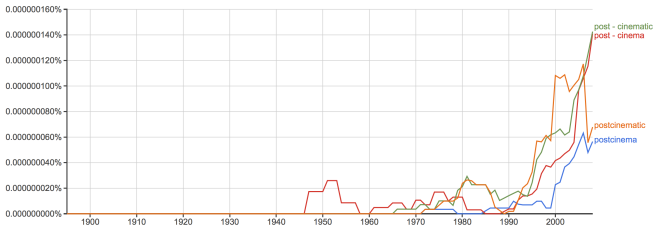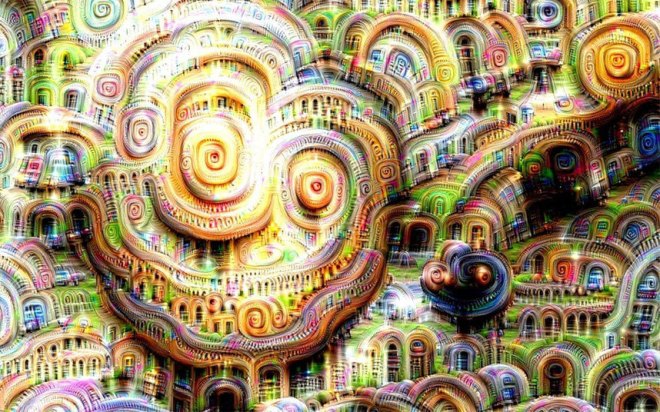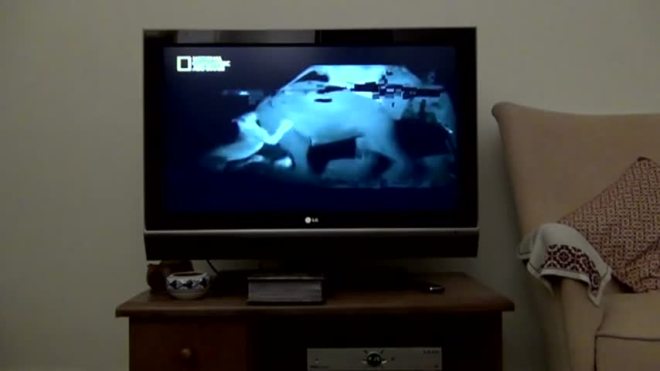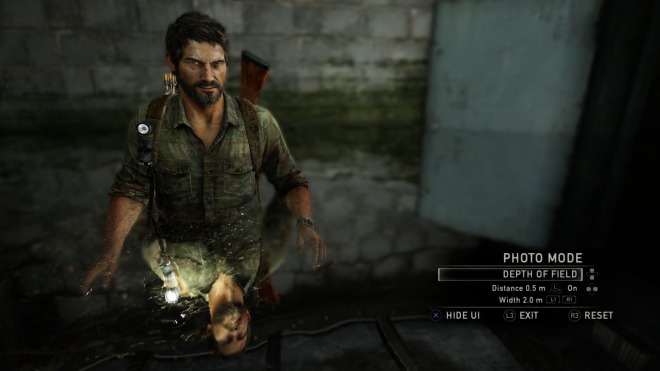
Month: July 2016
Generativity and Creative Agency in Post-Cinematic Media — SLSA 2016 Panel

I am excited to be chairing and participating in the panel “Generativity and Creative Agency in Post-Cinematic Media” at the 2016 conference of the Society for Literature, Science, and the Arts (SLSA), which will be taking place this year in Atlanta, November 3-6, 2016. Below you will find the panel description and links to the individual abstracts.
Generativity and Creative Agency in Post-Cinematic Media
SLSA 2016 Panel
Chair: Shane Denson, Stanford University
This panel seeks to elucidate the generative potentials and creative agencies of contemporary audiovisual media, or post-cinematic media. We explore these potentials in terms of technological, aesthetic, affective, and political processes involved in 21st-century media, theorizing their impact on the images that dominate our experience of the contemporary lifeworld. Collectively, these presentations provide a picture of post-cinema as a field of material, cultural, informatic, and ideological agencies—a media regime that exhibits an unprecedented form of productivity, or creative force, owing in part to the shift from a photographic-indexical to a computational ontology, but continuing to speak to human sensibilities through images that actively generate an interface with sub-perceptual and informational processes.
Shane Denson’s contribution introduces the notion of post-cinema as a framework for contemporary experience—a generative framework that displaces human perspectives while simultaneously re-situating them with respect to the microtemporal processes that subtend perception in the age of digital, networked media. Mark Hansen’s talk turns to the use of military drones in the production of strategic and aesthetic images, questioning the relation between the visual and the informatic. Ozgun Eylul Iscen picks up this thread and links the political power of post-cinematic images to the generative power of the glitch, a phenomenon which hovers between properly perceptual and infrastructural registers. Finally, Jason Lajoie’s contribution focuses on interactive potentials and the reconfiguration of photographic media and agencies in contemporary videogames.
Abstracts for the individual papers:
Shane Denson, “Post-Cinema as a Generative Media Regime”
Ozgun Eylul Iscen, “Indexicality as ‘Shadow Archive’ in Post-Cinema”
Mark B. N. Hansen, “Between Information and Fabulation: Cinema After Drones”
Jason Lajoie, “Playing the Photographer: Creative Self-Expression through In-Game Photography”
Post-Cinema as a Generative Media Regime — Shane Denson

My abstract for the panel “Generativity and Creative Agency in Post-Cinematic Media” at SLSA 2016 in Atlanta:
Post-Cinema as a Generative Media Regime
Shane Denson, Stanford University
This presentation examines recent theories and approaches to post-cinema, understood broadly as the informatically informed audio-visual media regime that follows in the wake of electronic and digital media’s absorption and re-tooling of cinematic technologies and modes of representation. Taking cues from Steven Shaviro’s Post-Cinematic Affect (2010) and the diverse contributions to the collection Post-Cinema: Theorizing 21st-Century Film (2016, co-edited by Shane Denson and Julia Leyda), among others, I aim in particular to foreground the ways in which what has often been conceived in terms of loss (e.g. the loss of indexicality, the demise of celluloid, or the death of cinema as an institution or context for collective reception) inevitably also involves an additive or generative moment—a moment of technical and cultural creation informed by the microtemporal and computational processes that displace and transform the photographic ontology of cinema. Such generativity has been glimpsed in a variety of critical and theoretical statements, such as Lev Manovich’s argument that digital processes render all images “animation,” Steven Shaviro’s focus on “affect” as the pre-perceptual site of these images’ registration, or Vivian Sobchack’s recent meditations on the emergence of a new spatiotemporal dimension within the “screen-sphere” that now encompasses all of human life. As of yet, however, these approaches have not been synthesized into a more general, comprehensive framework of post-cinematic generativity. This talk aims to make a step in this direction by identifying the technical, phenomenological, and pre-personal foundations of the post-cinematic media regime and its particular mechanisms of creative agency.
Indexicality as “Shadow Archive” in Post-Cinema — Ozgun Eylul Iscen

Ozgun Eylul Iscen’s abstract for the panel “Generativity and Creative Agency in Post-Cinematic Media” at SLSA 2016 in Atlanta:
Indexicality as “Shadow Archive” in Post-Cinema
Ozgun Eylul Iscen, Duke University
If technical infrastructures are no longer homogenous with surface appearances in the era of computerized and networked media, how can we reach out to the structures that are not available to us immediately but that underlie the very constitution of the digital image itself? Can a digital image become an index of its own mediation? In this paper, I draw upon Akira Mazuta Lippit’s notion of the “shadow archive” (as inspired by Derrida); the concept underlines an accumulation of accidental recollections and enfolded traces at the edge of visibility, thus taking the form of “avisuality.” I propose that the notion of shadow archive could play a key role in mapping out the diverse layers of digital processes that act while remaining invisible. This raises questions about whether it is possible to trace back those layers, what kind of aesthetics would be called for, and what the political significance would be. For instance, glitch, as an error within a digital image, can be indexical of an ‘accident’ in hardware or in the material infrastructure (e.g. electricity). While the visibility of a digital image deteriorates, the invisible but constitutive elements of the image come to the surface. Thus, glitch reminds us of digital information’s analog roots, confronts the apparent perfectness of the digital, and reveals both the materiality and the ideology that digital media are built on. I argue that this understanding of indexicality as a shadow archive underscores digital imagery’s analog roots and its processual and immanent nature.
Between Information and Fabulation: Cinema After Drones — Mark B. N. Hansen

Mark Hansen’s abstract for the panel “Generativity and Creative Agency in Post-Cinematic Media” at SLSA 2016 in Atlanta:
Between Information and Fabulation: Cinema After Drones
Mark Hansen, Duke University
This talk focuses on the use of high speed digital video cameras onboard Unmanned Aerial Vehicles or military drones to gather “intelligence, surveillance, and reconnaissance” (ISR). In order to address the key “aesthetic” issue involved here—the question of whether such ISR can be said to operate through the register of the visible, and thus the question of where to locate its cinematic dimension—I shall approach the images generated by drone reconnaissance on two planes: as a source of information that can only be analyzed by computers and as a “vision machine” that renders visibility asymmetrical in order to identify it with power. My talk will think with and through Israeli artist Omer Fast’s 2011 video 5000 Feet is the Best in order to explore: 1) the decoupling of “cinema” from human perception that is at issue in ISR images; and 2) how a cinematic aesthetic can create an indirect perceptual interface onto the imperceptible, informational domain “machinically-presentified” by and through these images.
Playing the Photographer: Creative Self-Expression through In-Game Photography — Jason Lajoie

Jason Lajoie’s abstract for the panel “Generativity and Creative Agency in Post-Cinematic Media” at SLSA 2016 in Atlanta:
Playing the Photographer: Creative Self-Expression through In-Game Photography
Jason Lajoie, University of Waterloo
The photo editor mode offered in The Last of Us Remastered (TLOUR), Naughty Dog’s 2014 Playstation 4 port of their 2013 Playstation 3 game, offers players the means to take a photo at any point in the game. This option alters and can also elevate user engagement within the game. It can also make statements about self-expression through gameplay, as notably illustrated by conflict photographer Ashley Gilbertson, who applied the same techniques he acquired in real-world conflict zones to the fictitious battlegrounds in the game, achieving his photographs by considering his situatedness as real spectator in virtual environments. From a game studies perspective, the photo editor mode enables new ways for players and designers to think about game design, and offers innovative means of expression for players to interact in a creative game space. My investigation draws on Roland Barthes’s exploration into the affective capacity of photographs, and Jose Van Dijck’s claim that the malleability and manipulability of digital photography affects the formation of identity by repurposing our memories and means of communication. What are the affective resonances of photographs on real spectators when the spectrum itself is virtual? By exploring the use of photo editor modes in TLOUR, and in other Playstation 4 titles like The Order: 1886, I consider the ways this program expands the affordances of gameplay and narrativity by providing players interactive means for creative expression in otherwise restrictive and linear game modes.